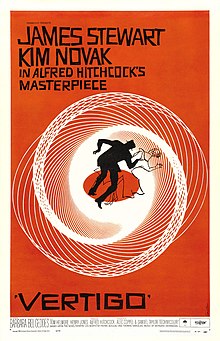| Vertigo | |
|---|---|
 Theatrical release poster by Saul Bass | |
| Directed by | Alfred Hitchcock |
| Screenplay by | |
| Based on | D'entre les morts 1954 novel by Pierre Boileau and Thomas Narcejac |
| Produced by | Alfred Hitchcock |
| Starring | |
| Cinematography | Robert Burks |
| Edited by | George Tomasini |
| Music by | Bernard Herrmann |
Production company | Alfred J. Hitchcock Productions |
| Distributed by | Paramount Pictures[a] |
Release date |
|
Running time | 128 minutes |
| Country | United States |
| Language | English |
| Budget | $2.5 million[3] |
| Box office | $7.3 million[4] |
Vertigo is a 1958 American psychological thriller film directed and produced by Alfred Hitchcock. The story was based on the 1954 novel D'entre les morts (From Among the Dead) by Boileau-Narcejac, with a screenplay by Alec Coppel and Samuel A. Taylor. The film stars James Stewart as a former San Francisco police detective who has retired after an incident in the line of duty caused him to develop an extreme fear of heights accompanied by vertigo. He is hired as a private investigator to report on the strange behavior of an acquaintance's wife (Kim Novak).
The film was shot on location in San Francisco, as well as in Mission San Juan Bautista, Big Basin Redwoods State Park, Cypress Point on 17-Mile Drive, and at Paramount Studios in Hollywood. The film stock of the camera negative was Eastman 25 ASA tungsten-balanced 5248 with processing and prints by Technicolor.[5][6] It was the first film to use the dolly zoom, an in-camera effect that distorts perspective to create disorientation, to convey Scottie's acrophobia; the technique is often referred to as "the Vertigo effect" in reference to its use in the film. In 1996, the film underwent a major restoration to create a new 70 mm print and DTS soundtrack.
Vertigo received mixed reviews on release, but it has since come to be considered Hitchcock's magnum opus and one of the greatest films of all time.[7] In 1989, it was one of the first 25 films selected by the Library of Congress for preservation in the United States National Film Registry for being "culturally, historically, or aesthetically significant".[8][9] The film appears repeatedly in polls of the best films by the American Film Institute, including a 2007 ranking as the ninth-greatest American film ever.[10] Attracting significant scholarly attention, it replaced Citizen Kane as the greatest film ever made in the 2012 Sight & Sound Greatest Films of All Time poll,[11] and came in second place in the 2022 edition of the poll.[12]
- ^ McGilligan 2003, p. 653.
- ^ Rossen, Jake (February 5, 2016). "When Hitchcock Banned Audiences From Seeing His Movies". Mental Floss. Retrieved September 9, 2020.
- ^ Kerbel, Michael. "Film Notes: VERTIGO | Yale University Library". web.library.yale.edu. Retrieved March 24, 2024.
- ^ "Vertigo (1958)". Box Office Mojo. Retrieved September 2, 2016.
- ^ Harris, Robert A. "Eastman Color, Dye Fade, Yellow Layer Failure... and Restoration". The Digital Bits. Retrieved January 18, 2024.
- ^ Flueckiger, Barbara. "Comparison of three different Technicolor dye-transfer prints of Vertigo (USA 1958, Alfred Hitchcock), originally shot in VistaVision". Timeline of Historical Film Colors. Retrieved January 18, 2024.
- ^ Bradshaw, Peter (August 1, 2012). "Vertigo's rise up the film critics' top 10 is a fascinating case study in reputation". The Guardian. ISSN 0261-3077. Retrieved October 31, 2023.
- ^ "ENTERTAINMENT: Film Registry Picks First 25 Movies". Los Angeles Times. Washington, D.C. September 19, 1989. Retrieved April 22, 2020.
- ^ "Complete National Film Registry Listing". Library of Congress. Retrieved May 14, 2020.
- ^ "AFI's 10 Top 10". American Film Institute. Retrieved February 21, 2012.
- ^ "Vertigo is named 'greatest film of all time'". BBC News. August 2, 2012. Retrieved August 18, 2012.
- ^ Cite error: The named reference
:0was invoked but never defined (see the help page).
Cite error: There are <ref group=lower-alpha> tags or {{efn}} templates on this page, but the references will not show without a {{reflist|group=lower-alpha}} template or {{notelist}} template (see the help page).